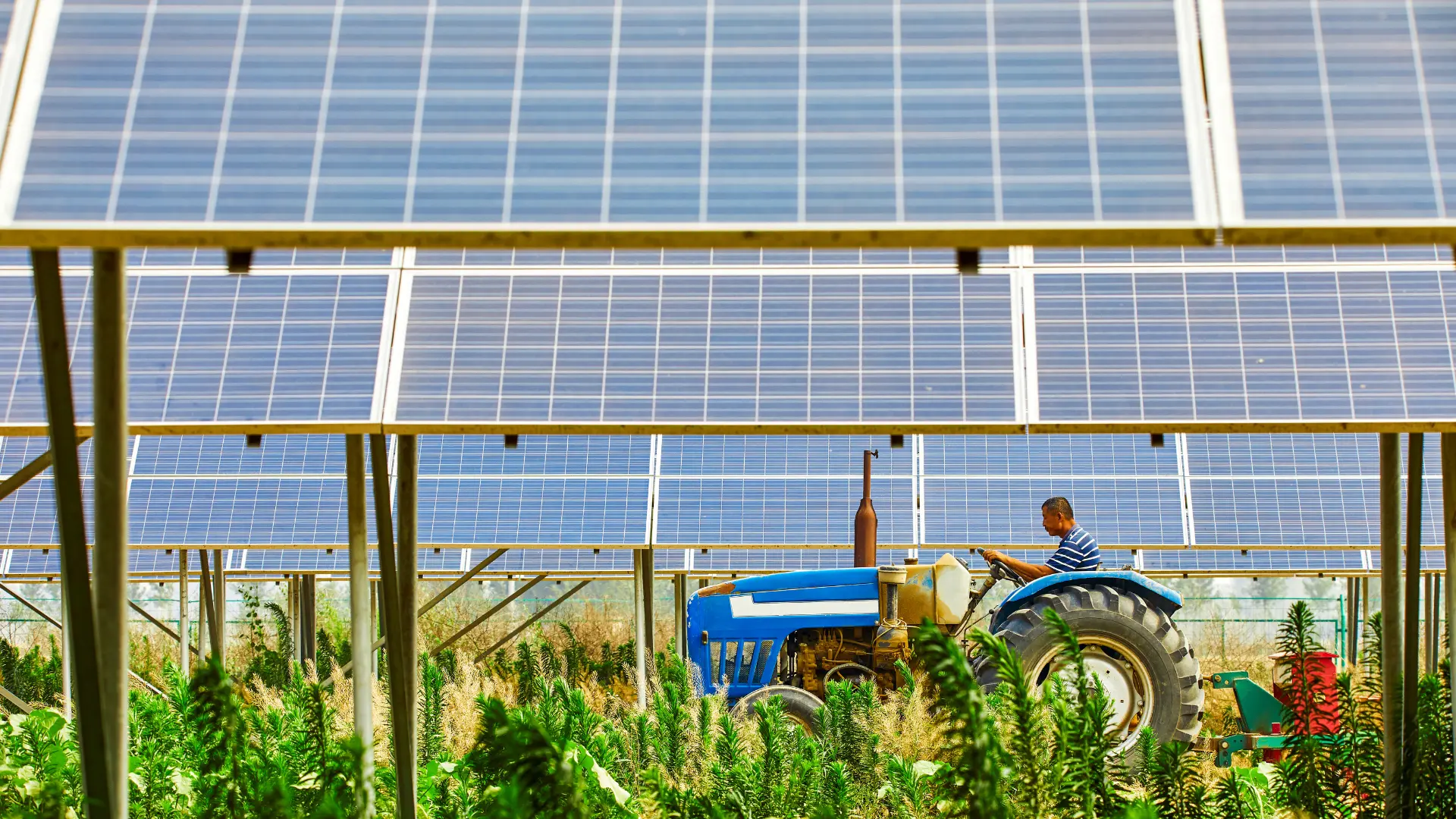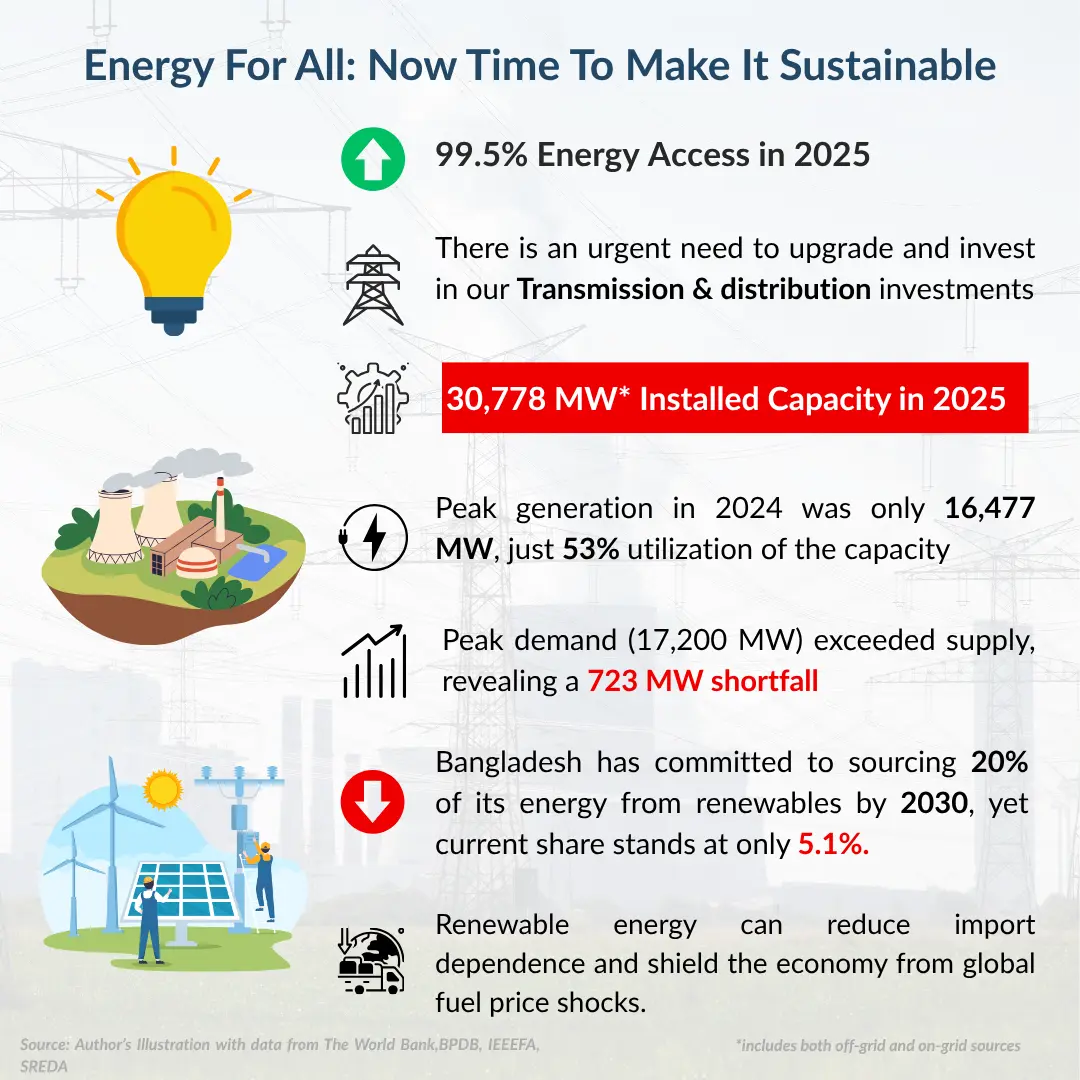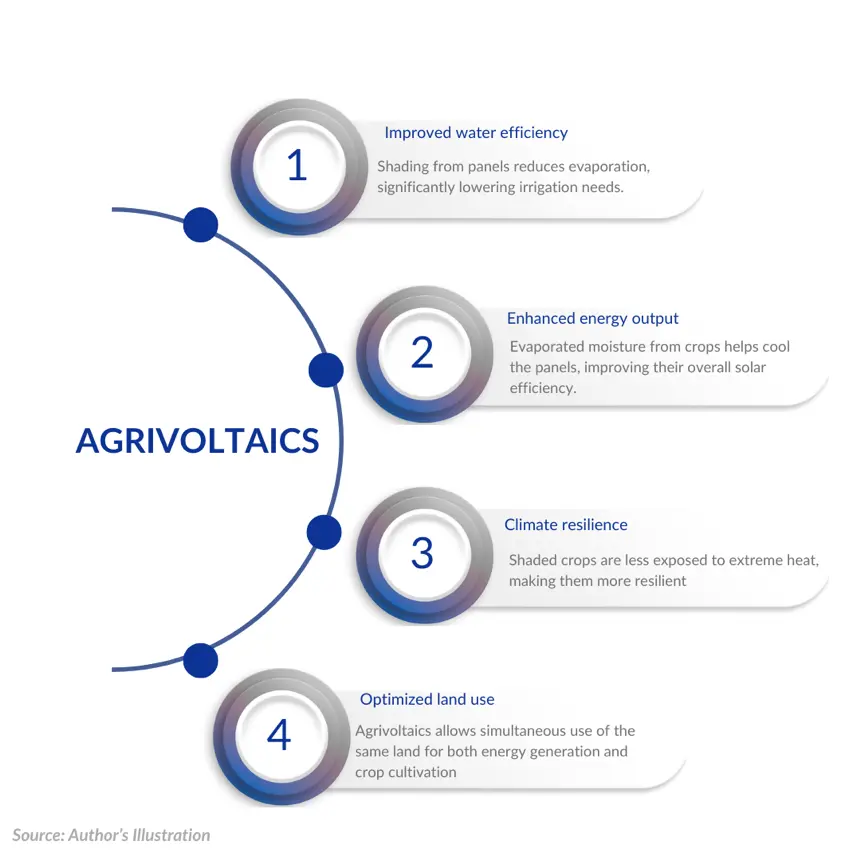GET IN TOUCH
- Please wait...

Bangladesh has come a long way in electrifying its population, but power security and sustainability remain out of reach. As power plants sit idle and capacity charges pile up, questions loom over the sector’s long-term strategy, especially with renewables forming only a fraction of the energy mix.

Figure 1 : Bangladesh’s Energy Sector Outlook
Several critical barriers remain unaddressed, including a lack of adequate funding, an outdated grid infrastructure, and minimal financial sector involvement. In FY23, renewable energy financing accounted for just 0.3% of total term loans, with less than 1% of all term loans directed toward this sector, underscoring a significant underinvestment from banks and non-bank financial institutions (NBFIs).[i] This is equally reflected in the refinancing scheme of Bangladesh Bank as well.

Figure 2 Percentage Share of Loans Disbursed in 2023 under BB’s Refinance Scheme
When we look at the current renewable energy mix, it is largely dominated by solar power. However, given the country’s severe land constraints, driven by a high population density and the need to preserve agricultural land, the feasibility of developing large-scale solar parks is highly limited.
This challenge adds to the uncertainty around achieving the revised target of 20% renewable energy by 2030. While other sources such as hydropower, wind energy, and rooftop solar do exist but they are not sufficient on their own to bridge the gap.
This is where agrivoltaics presents a sustainable solution, allowing the same land to be used for both agriculture and solar energy generation, thus addressing the dual challenges of food security and clean energy transition. Moreover, agrivoltaics could also pave the way for our farmers to earn extra returns on their lands as the yield would come from both Agri produce and energy that will be produced from the solar panels.
However, the concern might arise that putting up solar panels might cause more land usage than a powerplant, the theory has been debunked by a more holistic model which accounts for indirect or “upstream” land usage.
A study done by researchers at BRAC University shows that oil and gas have the highest land demands, requiring 3.15 and 1.5 million hectares per year, respectively. In contrast, agrivoltaic systems require just 4,845 hectares annually, making them the least land-intensive option.[ii]

Figure 3 Arable Land and Urban Population Growth (1971–2022)
Bangladesh is one of the most densely populated countries in the world, and its population has been growing at a steady pace. As a result, the amount of arable land available per capita has been shrinking.
Figure 3 illustrates a clear inverse relationship: as the urban population has steadily increased from 7.91% in 1971 to 39.71% in 2022, the percentage of arable land has declined, falling from 67.88% to just under 60.52%. This trend underscores the critical land-use challenge Bangladesh faces, a growing need for food and housing, but with a diminishing agricultural footprint.
It is estimated that Bangladesh loses around 80,000 hectares of fertile agricultural land every year, driven by rapid urban expansion, road construction, housing, and other infrastructure projects.[iii] Compounding the issue, climate-induced sea level rise is projected to submerge 17% of the country’s territory by 2050, potentially erasing 30% of its remaining agricultural land.[iv] This climate displacement is already pushing coastal populations into overcrowded urban areas, putting even more pressure on Bangladesh’s limited land resources.
In the face of challenges around food and energy security, particularly in a land-scarce country like Bangladesh, agrivoltaics presents a promising dual-use solution. If implemented strategically, this approach, combining solar energy generation with agricultural production on the same land, could play a transformative role in safeguarding the country’s economic future.
Agrivoltaics refers to the practice of utilizing agricultural land for both crop cultivation and solar energy generation simultaneously. This dual-use model is particularly effective in land-scarce countries like Bangladesh, where the use of Agricultural land is protected under the Land Transformation Act.
Under agrivoltaic systems, crops that require partial sunlight or thrive in shaded conditions are grown beneath elevated solar photovoltaic (PV) panels. Vegetables and crops such as tomato, potato, cotton, tea, coffee, garlic, onion, and turmeric are particularly well-suited for this environment. These crops benefit from the moderated sunlight, which can improve yields and reduce crop stress during extreme heat.

Figure 4: Benefits of Agrivoltaics
One key question that arises for Bangladesh is whether agrivoltaics (APV) might affect the yield of rice, given that rice is one of the country’s staple crops and most global APV studies focus on crops that require less sunlight. In this context, a recent field-based study explored the impact of a APV installation on BRRI-33, a major rice variety in Bangladesh.
The research found that intermittent shading caused by solar panels did not significantly reduce rice yield. In fact, shaded plots exhibited higher chlorophyll content, taller plants, and more biomass which suggests potential co-benefits for bioenergy.[v]
Additionally, shaded areas maintained favorable soil pH, lower soil temperature, and better water retention, all of which supported healthy crop development. While further studies across soil types, seasons, and other rice varieties are needed, this pilot study indicates that APV can be compatible with rice cultivation in Bangladesh without compromising productivity.
Agrivoltaics has been gaining momentum in all over the world with the increasing global population and the need to utilize the lands in a better way. One of the global best-case scenario of agrivoltaics in action is Jack’s Solar Garden in Longmont, Colorado which is currently the largest commercially active agrivoltaic system in the United States. The farm is 24-acres and has 3200 solar panels installed in it which generates 1.2 megawatts of electricity annually while also producing 8,000 pounds of fresh produce.
This system not only transformed an unprofitable hay farm into a productive solar-agriculture hybrid but also demonstrated that agriculture and clean energy generation can coexist and reinforce one another.
A groundbreaking demonstration of agrivoltaic potential comes from the Heggelbach test site[vi] in Germany. Researchers from Fraunhofer ISE found that combining solar power generation with potato cultivation on the same land resulted in a land-use efficiency of 186%. Compared to using separate plots for solar and agriculture (100% each), the agrivoltaic system achieved:
A 100 MW semi-agrivoltaic project is being developed in Madarganj, Jamalpur by B-R Powergen Ltd. and CREC International. Covering 350 acres, the plant will generate solar power while growing crops like green chilies, turmeric, and ginger beneath the panels. Expected to be operational by December 2025, the $170 million project aims to maximize land use, support local livelihoods, and promote sustainable energy generation.
Agrivoltaics is still at a nascent stage in Bangladesh, and the concept is under active development. As a result, such initiatives remain limited, with only a few notable examples like the Madarganj project currently in progress.
Building on global examples, Bangladesh can begin piloting agrivoltaics to better utilize limited land while advancing its renewable energy goals. To make this transition smooth and impactful, a collaborative effort is crucial. We need all hands-on deck, from government-level policymakers to private sector players, for this change to take root and scale.
Policymakers should integrate agrivoltaics into national land use, agriculture, and renewable energy policies by facilitating pilot projects on government-owned land. It is crucial that the Ministry of Land revises the existing 2016 draft land policy, which currently prohibits the use of agricultural land for non-agricultural purposes such as energy generation or industrial development.[vii]
Moreover, effective implementation of agrivoltaics in Bangladesh will require coordinated collaboration among the Ministry of Land, Ministry of Agriculture, and the Ministry of Power, Energy and Mineral Resources to ensure alignment of land use, agricultural productivity, and renewable energy goals.
Meanwhile, development partners and donor agencies have a critical role to play in funding feasibility studies and piloting on-ground interventions, initiatives have been taken by a few already. By linking agrivoltaics with broader climate adaptation goals and SDG targets, they can help scale the model sustainably.
Their support can also extend to technical assistance, training, and capacity-building initiatives to empower rural communities, agri-entrepreneurs, and agricultural workers to adopt and benefit from this model.
On the other hand, the private sector can explore innovative Public-Private Partnership (PPP) models to invest in agrivoltaic farms, aligning these efforts with their ESG commitments. By working with farmer cooperatives and leveraging scalable agri-solar business models, private enterprises can help establish agrivoltaics as a commercially viable and climate-resilient solution.
However, the most critical piece of the puzzle is upgrading the national grid’s infrastructure. To make the most of the Net Energy Metering system, allowing consumers to sell excess electricity back to the grid, significant investment is needed.
Without this, we risk exacerbating the existing overcapacity issue. The National Budget 2025 has rightly allocated substantial funding for grid improvements, which is a commendable step from the government.
Together, these multi-stakeholder actions can transform agrivoltaics from a promising concept into a practical tool for achieving Bangladesh’s food and energy security ambitions.
This article was authored by Sakina Binte Belayet, a Business Analyst at LightCastle Partners. Advisory and editorial support was provided by Rakinul Islam, Business Consultant at LightCastle Partners. For further clarifications, contact us here : [email protected]
[i] Funding shortfall threatens renewable energy goals
[ii] Kamal, F., & Bin Azam, S. M. (2024). Climate-smart energy planning: A framework for assessing sustainability trade-offs in Bangladesh’s power sector (IGC Working Paper, February 2024). International Growth Centre (IGC).an
[iii] Rozario, S. R., Rezaie, A. M., & Khan, M. R. (2021). Insights on land use, agriculture and food security in Bangladesh: way forward with climate change and development. Agriculture for Development, 44, 32–39.
[iv] International Monetary Fund. (2019). Bangladesh: Selected issues (IMF Country Report No. 19/278).
[v] Sarker Joy, Khan Imran, & Swaraz AM (2023). A non-traditional Agrophotovoltaic installation and its impact on cereal crops: A case of the BRRI-33 rice variety in Bangladesh.
[vi] Agrivoltaics: Opportunities for Agriculture and the Energy Transition
[vii] Environmental and economic impacts of agrivoltaics in Bangladesh
Our experts can help you solve your unique challenges
Stay up-to-date with our Thought Leadership and Insights